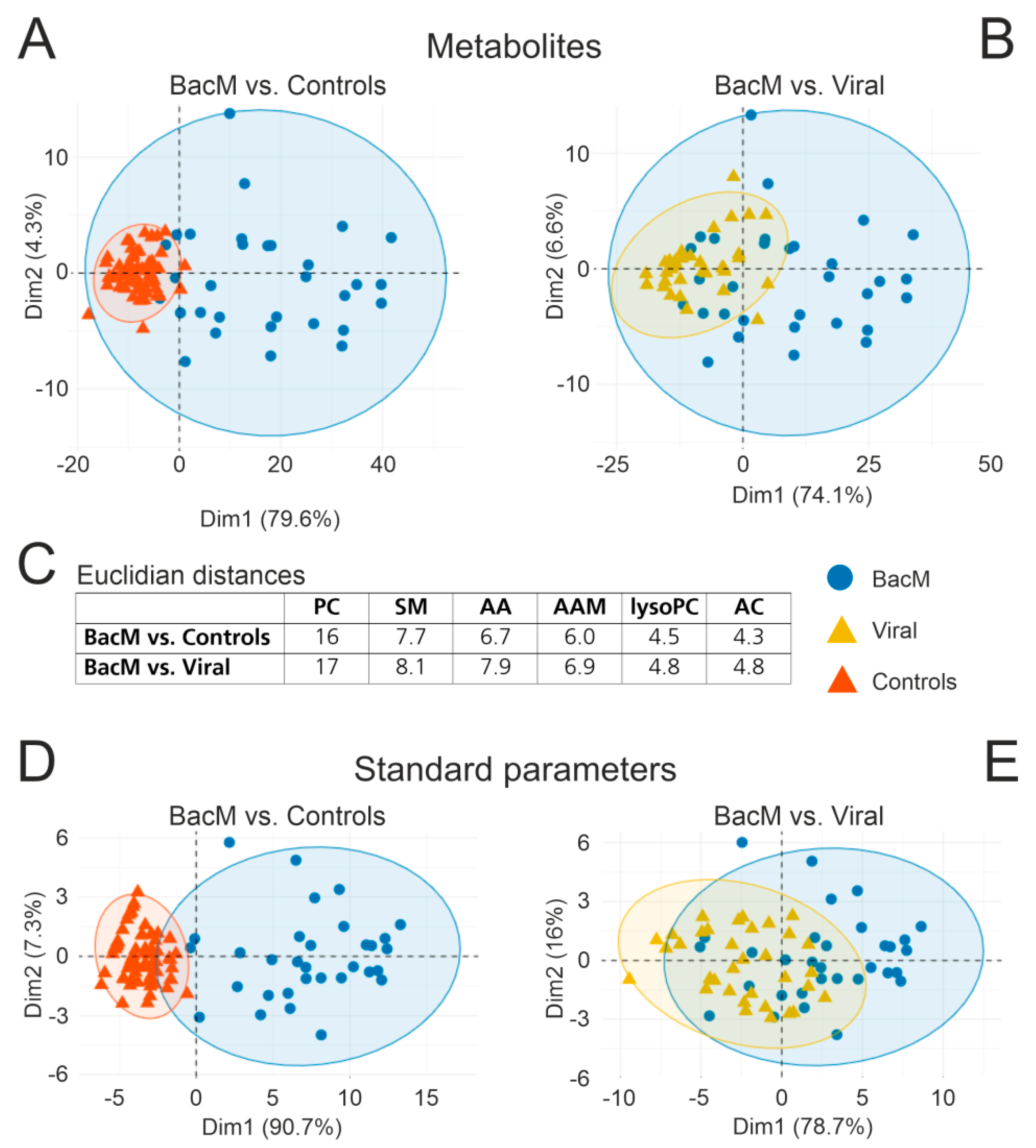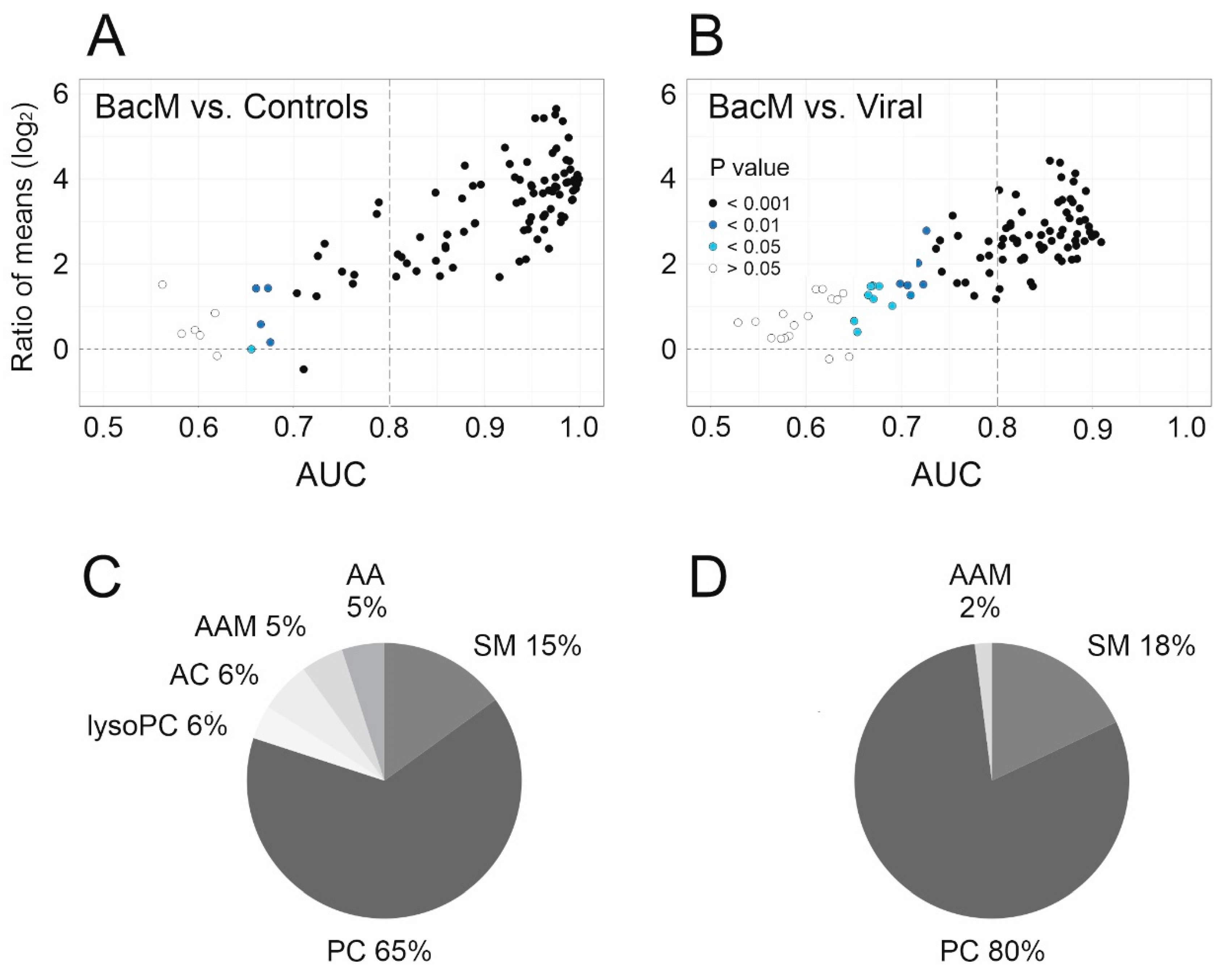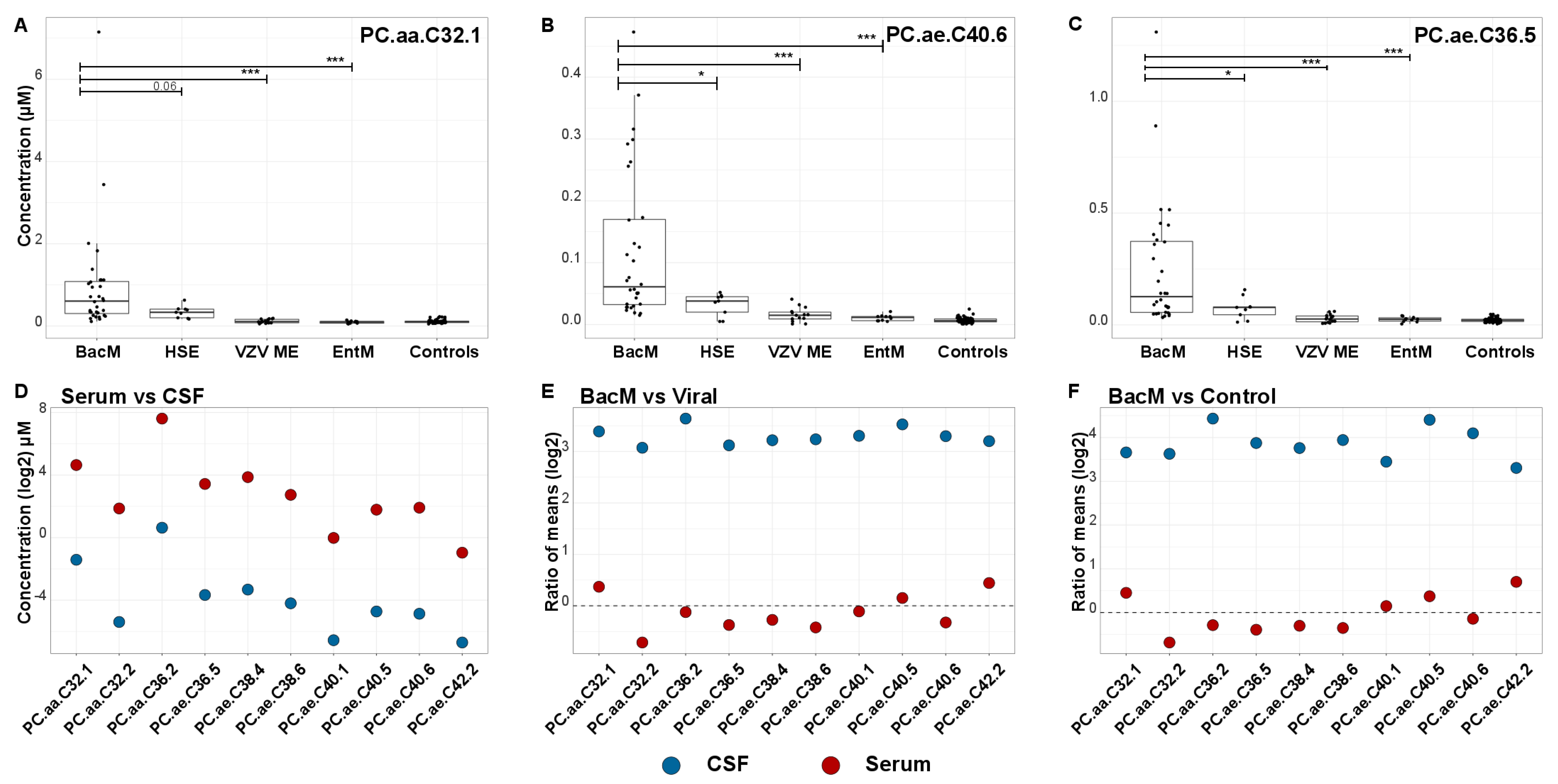Elevated Free Phosphatidylcholine Levels in Cerebrospinal Fluid Distinguish Bacterial from Viral CNS Infections
Abstract
1. Introduction
2. Methods
2.1. Study Cohort
2.2. Standard Clinical Diagnostic Parameters
2.3. Targeted Metabolomics
2.4. Quality Screen
2.5. Statistical Analysis
3. Results
3.1. Study Cohort
3.2. General Differences in CSF Metabolite Populations between Bacterial and Viral CNS Infections
3.3. Biomarker Screening and Internal Validation
3.4. Correlations with Parameters of Systemic and CNS Inflammation
3.5. Differentiation between Bacterial Etiologies
3.6. Increased Phosphatidylcholine Concentrations in CSF but Not Serum
4. Discussion
5. Conclusions and Outlook
Supplementary Materials
Author Contributions
Funding
Institutional Review Board Statement
Informed Consent Statement
Data Availability Statement
Acknowledgments
Conflicts of Interest
References
- World Health Organization. Meningococcal Meningitis: Fact Sheet 2018. Available online: https://www.who.int/news-room/fact-sheets/detail/meningococcal-meningitis (accessed on 15 December 2020).
- Aronin, S.I.; Peduzzi, P.; Quagliarello, V.J. Community-acquired bacterial meningitis: Risk stratification for adverse clinical outcome and effect of antibiotic timing. Ann. Intern. Med. 1998, 129, 862–869. [Google Scholar] [CrossRef] [PubMed]
- Durand, M.L.; Calderwood, S.B.; Weber, D.J.; Miller, S.I.; Southwick, F.S.; Caviness, V.S., Jr.; Swartz, M.N. Acute bacterial meningitis in adults. A review of 493 episodes. N. Engl. J. Med. 1993, 328, 21–28. [Google Scholar] [CrossRef] [PubMed]
- Kohil, A.; Jemmieh, S.; Smatti, M.K.; Yassine, H.M. Viral meningitis: An overview. Arch. Virol. 2021, 166, 335–345. [Google Scholar] [CrossRef] [PubMed]
- McGill, F.; Griffiths, M.J.; Bonnett, L.J.; Geretti, A.M.; Michael, B.D.; Beeching, N.J.; McKee, D.; Scarlett, P.; Hart, I.J.; Mutton, K.J. Incidence, aetiology, and sequelae of viral meningitis in UK adults: A multicentre prospective observational cohort study. Lancet Infect. Dis. 2018, 18, 992–1003. [Google Scholar] [CrossRef]
- Calleri, G.; Libanore, V.; Corcione, S.; De Rosa, F.G.; Caramello, P. A retrospective study of viral central nervous system infections: Relationship amongst aetiology, clinical course and outcome. Infection 2017, 45, 227–231. [Google Scholar] [CrossRef] [PubMed]
- Jain, R.; Chang, W.W. Emergency department approach to the patient with suspected central nervous system infection. Emerg. Med. Clin. North Am. 2018, 36, 711–722. [Google Scholar] [CrossRef]
- Young, N.; Thomas, M. Meningitis in adults: Diagnosis and management. Intern. Med. J. 2018, 48, 1294–1307. [Google Scholar] [CrossRef]
- Benninger, F.; Steiner, I. CSF in acute and chronic infectious diseases. Handb. Clin. Neurol. 2017, 146, 187–206. [Google Scholar]
- Brouwer, M.C.; Thwaites, G.E.; Tunkel, A.R.; van de Beek, D. Dilemmas in the diagnosis of acute community-acquired bacterial meningitis. Lancet 2012, 380, 1684–1692. [Google Scholar] [CrossRef]
- Suthar, R.; Sankhyan, N. Bacterial infections of the central nervous system. Indian J. Pediatrics 2019, 86, 60–69. [Google Scholar] [CrossRef] [PubMed]
- McGill, F.; Heyderman, R.S.; Panagiotou, S.; Tunkel, A.R.; Solomon, T. Acute bacterial meningitis in adults. Lancet 2016, 388, 3036–3047. [Google Scholar] [CrossRef]
- Tayebati, S.K.; Amenta, F. Choline-containing phospholipids: Relevance to brain functional pathways. Clin. Chem. Lab. Med. 2013, 51, 513–521. [Google Scholar] [CrossRef]
- Zweigner, J.; Jackowski, S.; Smith, S.H.; Van Der Merwe, M.; Weber, J.R.; Tuomanen, E.I. Bacterial inhibition of phosphatidylcholine synthesis triggers apoptosis in the brain. J. Exp. Med. 2004, 200, 99–106. [Google Scholar] [CrossRef] [PubMed]
- Ridgway, N.D. The role of phosphatidylcholine and choline metabolites to cell proliferation and survival. Crit. Rev. Biochem Mol. Biol. 2013, 48, 20–38. [Google Scholar] [CrossRef]
- Neal, J.W.; Gasque, P. How does the brain limit the severity of inflammation and tissue injury during bacterial meningitis? J. Neuropathol. Exp. Neurol. 2013, 72, 370–385. [Google Scholar] [CrossRef] [PubMed]
- Kuhn, M.; Sühs, K.-W.; Akmatov, M.K.; Klawonn, F.; Wang, J.; Skripuletz, T.; Kaever, V.; Stangel, M.; Pessler, F. Mass-spectrometric profiling of cerebrospinal fluid reveals metabolite biomarkers for CNS involvement in varicella zoster virus reactivation. J. Neuroinflammation. 2018, 15, 20. [Google Scholar] [CrossRef]
- Ratuszny, D.; Sühs, K.-W.; Novoselova, N.; Kuhn, M.; Kaever, V.; Skripuletz, T.; Pessler, F.; Stangel, M. Identification of Cerebrospinal Fluid Metabolites as Biomarkers for Enterovirus Meningitis. Int. J. Mol. Sci. 2019, 20, 337. [Google Scholar] [CrossRef]
- Sühs, K.-W.; Novoselova, N.; Kuhn, M.; Seegers, L.; Kaever, V.; Müller-Vahl, K.; Trebst, C.; Skripuletz, T.; Stangel, M.; Pessler, F. Kynurenine Is a Cerebrospinal Fluid Biomarker for Bacterial and Viral Central Nervous System Infections. J. Infect. Dis 2019, 220, 127–138. [Google Scholar] [CrossRef] [PubMed]
- de Araujo, L.S.; Pessler, K.; Sühs, K.-W.; Novoselova, N.; Klawonn, F.; Kuhn, M.; Kaever, V.; Müller-Vahl, K.; Trebst, C.; Skripuletz, T. Stangel, M. Pessler, F. Phosphatidylcholine PC ae C44:6 in cerebrospinal fluid is a sensitive biomarker for bacterial meningitis. J. Transl. Med. 2020, 18, 9. [Google Scholar] [CrossRef]
- Reiber, H. Cerebrospinal fluid--physiology, analysis and interpretation of protein patterns for diagnosis of neurological diseases. Multple Scler. 1998, 4, 99–107. [Google Scholar]
- Biocrates Life Sciences. MxP Quant 500 kit: Analytical Specifications; Biocrates Life Sciences: Innsbruck, Austria, 2020. [Google Scholar]
- Le, S.; Josse, J.; Husson, F. FactoMineR: A package for multivariate analysis. J. Stat. Softw. 2008, 25, 1–18. [Google Scholar] [CrossRef]
- Kassambra, A.; Mundt, F. Factoextra: Extract and Visualize the Results of Multivariate Data Analyses. 2020. Available online: https://cloud.r-project.org/package=factoextra (accessed on 15 November 2020).
- Sing, T.; Sander, O.; Beerenwinkel, N.; Lengauer, T. ROCR: Visualizing classifier performance in R. Bioinformatics 2005, 21, 3940–3941. [Google Scholar] [CrossRef]
- Varma, S.; Simon, R. Bias in error estimation when using cross-validation for model selection. BMC Bioinform. 2006, 7, 91. [Google Scholar] [CrossRef] [PubMed]
- Szymanska, E.; Saccenti, E.; Smilde, A.K.; Westerhuis, J.A. Double-check: Validation of diagnostic statistics for PLS-DA models in metabolomics studies. Metabolomics 2012, 8 (Suppl. 1), 3–16. [Google Scholar] [CrossRef]
- Smit, E.; van Breemen, M.J.; Hoefsloot, H.C.J.; Smilde, A.K.; Aerts, J.M.F.G.; de Koster, C.G. Assessing the statistical validity of proteomics based biomarkers. Anal. Chim. Acta 2007, 592, 210–217. [Google Scholar] [CrossRef] [PubMed]
- Al-Mekhlafi, A.; Becker, T.; Klawonn, F. Sample size and performance estimation for biomarker combinations based on pilot studies with small sample sizes. Commun. Stat. Theory Methords 2020. [Google Scholar] [CrossRef]
- Klawonn, F.; Wang, J.; Koch, I.; Omar, M.; Eberhand, J. HAUCA curves for the evaluation of biomarker pilot studies with small sample sizes and large numbers of features. In Advances in Intelligent Data Analysis XV; Springer: Stockholm, Sweden, 2016. [Google Scholar]
- López-Ratón, M.; Rodríguez-Álvarez, M.X.; Cadarso-Suárez, C.; Gude-Sampedro, F. Optimal Cutpoints: An R package for selecting optimal cutpoints in diagnostic tests. J. Stat. Softw. 2014, 61, 1–36. [Google Scholar] [CrossRef]
- Arshad, H.; López Alfonso, J.C.; Franke, R.; Michaelis, K.; Araujo, L.; Habib, A.; Zboromyrska, Y.; Lücke, E.; Strungaru, E.; Akmatov, M.K.; et al. Decreased plasma phospholipid concentrations and increased acid sphingomyelinase activity are accurate biomarkers for community-acquired pneumonia. J. Transl. Med. 2019, 17, 365. [Google Scholar] [CrossRef]
- Sakushima, K.; Hayashino, Y.; Kawaguchi, T.; Jackson, J.L.; Fukuhara, S. Diagnostic accuracy of cerebrospinal fluid lactate for differentiating bacterial meningitis from aseptic meningitis: A meta-analysis. J. Infect. 2011, 62, 255–262. [Google Scholar] [CrossRef] [PubMed]




| Bacterial Meningitis | HSV Encephalitis | Enterovirus Meningitis | VZV Meningo- Encephalitis | Controls | |||
|---|---|---|---|---|---|---|---|
| Median (Range) | p Value | ||||||
| Age (years) | 51 (18–83) | 56 (29–76) | 39 (22–76) | 51 (13–80) | 50 (19–91) | 0.98 a | |
| Sex (female %) | 47 | 22 | 50 | 35 | 43 | 0.5 b | |
| Blood | Leukocyte count (1000/µL) | 16.2 (6.5–48.4) | 10.1 (1.8–12.8) | 7 (4–14) | 6.9 (3.8–13.6) | 6.8 (3.7–11.9) | 3.3 × e−11 a |
| C-reactive protein (mg/L) | 100 (1–429) | 3 (1–102) | 4 (1–39) | 2 (1–25) | 1.5 (0.3–31) | 8.6 × e−13 a | |
| CSF | Cell count (1/µL) | 764.9 (4.3–18,800) | 90.7 (16–723) | 9.2 (0.7–619) | 60.5 (1.7–1536) | 1 (0.3–11.3) | 2.2 × e−16 a |
| Lactate (mmol/L) | 7.2 (1.8–21.9) | 2.3 (1.8–3.4) | 1.8 (1.6–3.6) | 2.7 (1.5–5.5) | 1.6 (1.2–2.5) | 2.2 × e−16 a | |
| Standard Parameters | CSF Metabolites | |||||
|---|---|---|---|---|---|---|
| Parameter | AUC (95% CI) | Ratio of Means | Metabolite a | AUC (95% CI) | Ratio of Means | Selection Frequency (Non-Nested/Nested) b |
| CSF lactate | 0.93 *** (0.86–0.99) | 3.5 | PC.aa.C32.1 | 0.91 *** (0.84–0.97) | 5.70 | 1/1 |
| Blood CRP | 0.9 1 *** (0.83–0.97) | 11.4 | PC.ae.C40.6 | 0.90 *** (0.83–0.97) | 6.47 | 1/1 |
| Blood leukocytes | 0.85 *** (0.79–0.94) | 3.3 | PC.ae.C36.5 | 0.90 *** (0.83–0.96) | 6.24 | 1/1 |
| CSF cell count | 0.82 *** (0.70–0.91) | 21.7 | PC.ae.C38.4 | 0.90 *** (0.82–0.96) | 6.73 | 1/1 |
| CSF Protein | 0.81 *** (0.71–0.90) | 3.4 | PC.aa.C32.2 | 0.90 *** (0.82–0.96) | 7.35 | 1/0.9 |
| Q albumin | 0.80 *** (0.65–0.88) | 3.3 | PC.ae.C40.5 | 0.89 *** (0.81–0.96) | 13.12 | 0.98/0.6 |
| Q IgG | 0.77 *** (0.83–0.97) | 3.2 | PC.ae.C40.1 | 0.89 *** (0.80–0.96) | 8.21 | 0.94/0.7 |
| BCB disruption | 0.722 ** (0.60–0.84) | n/a | PC.ae.C38.6 | 0.89 *** (0.81–0.96) | 5.80 | 0.98/0.8 |
| IgG-index | 0.621 (0.51–0.77) | 0.99 | PC.aa.C36.2 | 0.89 *** (0.80–0.95) | 9.89 | 0.86/0.5 |
| PC.ae.C42.2 | 0.89 *** (0.80–0.96) | 8.01 | 0.70/0.5 | |||
| Biomarkers | Sensitivity | Specificity | PPV | NPV | Cut-Off Value |
|---|---|---|---|---|---|
| CSF_lactate | 0.88 | 0.91 | 0.90 | 0.88 | 3.9 mmol/L |
| CSF cell count | 0.75 | 0.79 | 0.77 | 0.77 | 240 cells/µL |
| Blood CRP | 0.91 | 0.85 | 0.85 | 0.9 | 24 mg/L |
| PC.aa.C32.1 | 0.91 | 0.82 | 0.83 | 0.90 | 0.22 µM |
| PC.ae.C40.6 | 0.91 | 0.74 | 0.76 | 0.89 | 0.02 µM |
| PC.ae.C36.5 | 0.91 | 0.74 | 0.76 | 0.89 | 0.05 µM |
| PC.ae.C38.4 | 0.75 | 0.85 | 0.83 | 0.78 | 0.11 µM |
| PC.aa.C32.2 | 0.94 | 0.68 | 0.73 | 0.92 | 0.01 µM |
Publisher’s Note: MDPI stays neutral with regard to jurisdictional claims in published maps and institutional affiliations. |
© 2021 by the authors. Licensee MDPI, Basel, Switzerland. This article is an open access article distributed under the terms and conditions of the Creative Commons Attribution (CC BY) license (https://creativecommons.org/licenses/by/4.0/).
Share and Cite
Al-Mekhlafi, A.; Sühs, K.-W.; Schuchardt, S.; Kuhn, M.; Müller-Vahl, K.; Trebst, C.; Skripuletz, T.; Klawonn, F.; Stangel, M.; Pessler, F. Elevated Free Phosphatidylcholine Levels in Cerebrospinal Fluid Distinguish Bacterial from Viral CNS Infections. Cells 2021, 10, 1115. https://doi.org/10.3390/cells10051115
Al-Mekhlafi A, Sühs K-W, Schuchardt S, Kuhn M, Müller-Vahl K, Trebst C, Skripuletz T, Klawonn F, Stangel M, Pessler F. Elevated Free Phosphatidylcholine Levels in Cerebrospinal Fluid Distinguish Bacterial from Viral CNS Infections. Cells. 2021; 10(5):1115. https://doi.org/10.3390/cells10051115
Chicago/Turabian StyleAl-Mekhlafi, Amani, Kurt-Wolfram Sühs, Sven Schuchardt, Maike Kuhn, Kirsten Müller-Vahl, Corinna Trebst, Thomas Skripuletz, Frank Klawonn, Martin Stangel, and Frank Pessler. 2021. "Elevated Free Phosphatidylcholine Levels in Cerebrospinal Fluid Distinguish Bacterial from Viral CNS Infections" Cells 10, no. 5: 1115. https://doi.org/10.3390/cells10051115
APA StyleAl-Mekhlafi, A., Sühs, K.-W., Schuchardt, S., Kuhn, M., Müller-Vahl, K., Trebst, C., Skripuletz, T., Klawonn, F., Stangel, M., & Pessler, F. (2021). Elevated Free Phosphatidylcholine Levels in Cerebrospinal Fluid Distinguish Bacterial from Viral CNS Infections. Cells, 10(5), 1115. https://doi.org/10.3390/cells10051115









